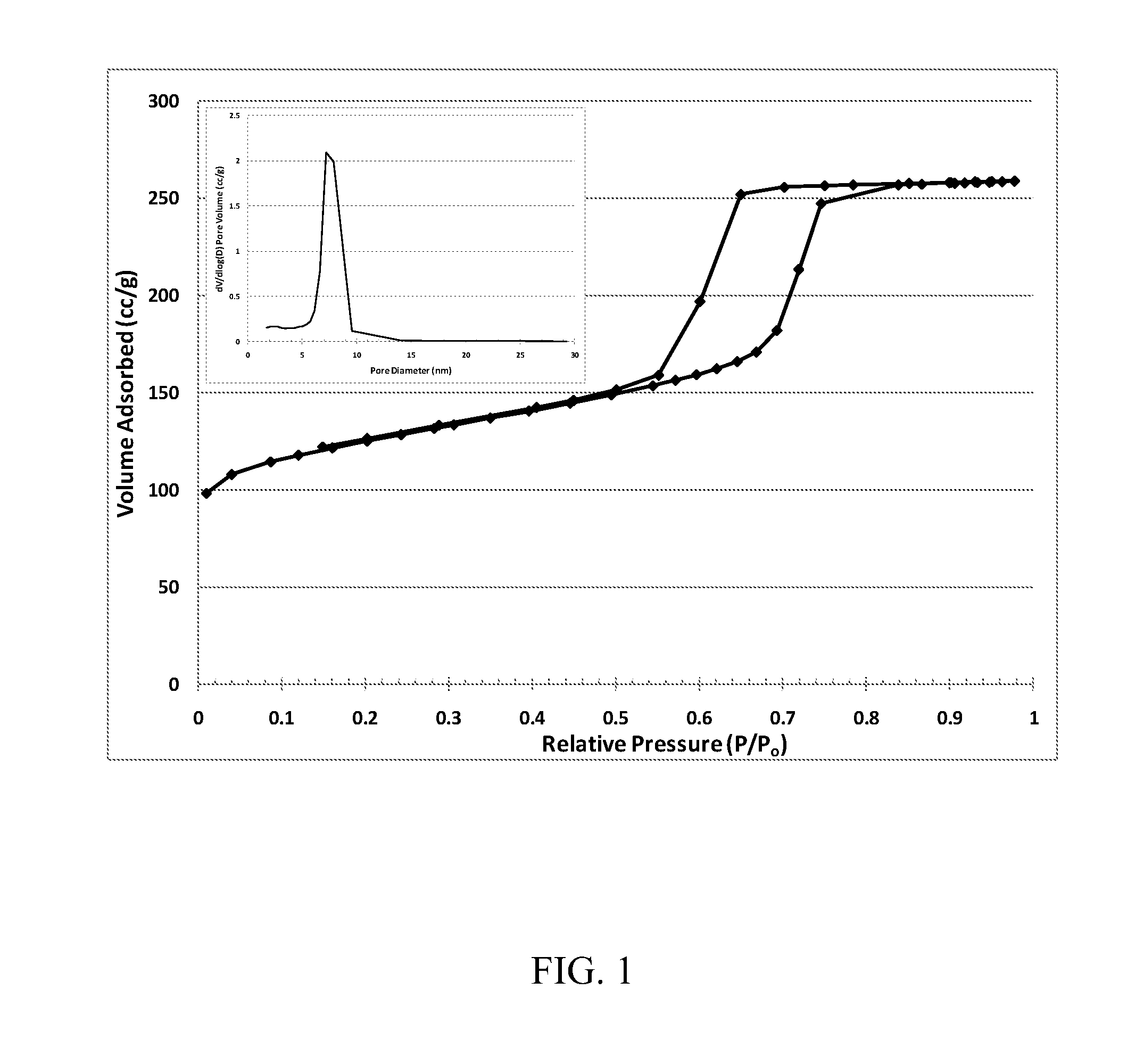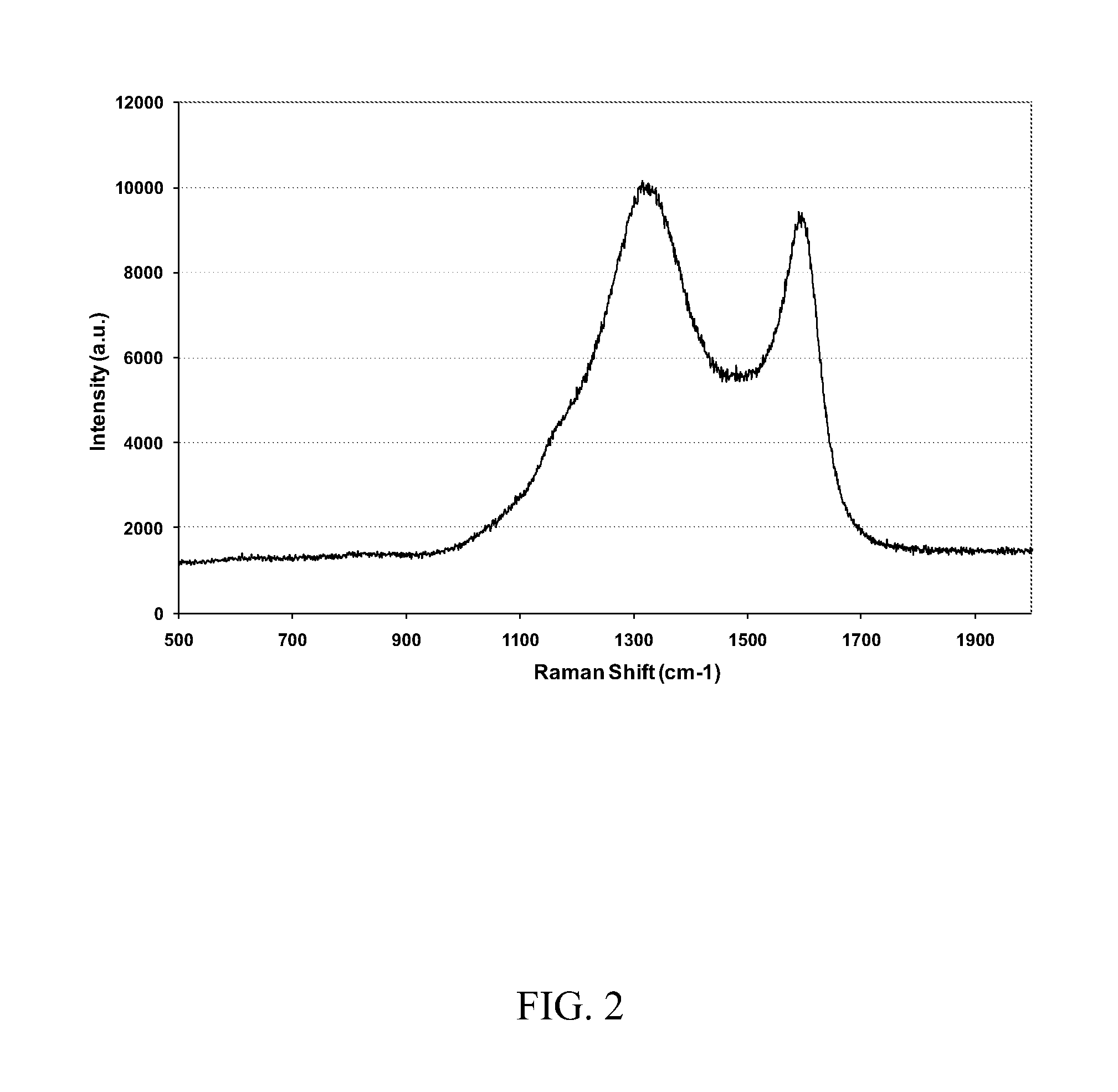Carbon composition with hierarchical porosity, and methods of preparation
a carbon composition and hierarchical porosity technology, applied in the field of porous carbon materials, can solve the problems of inability to achieve batch-to-batch repeatability, precise, and ordered sets of pore sizes in carbon materials, and achieve the effect of superior ion uptake kinetics
- Summary
- Abstract
- Description
- Claims
- Application Information
AI Technical Summary
Benefits of technology
Problems solved by technology
Method used
Image
Examples
example 1
Preparation of a Hierarchical Porous Carbon Film by Reacting Phloroglucinol and Glyoxal
[0082]Phloroglucinol, tetrahydrofuran (THF), and Pluronic F-127 were obtained from Sigma-Aldrich. Ethanol (200 proof) was obtained from VWR Scientific, and glyoxal was obtained from Alfa Aesar.
[0083]In a typical experiment, 1.15 g phloroglucinol (9.12 mmol) and 1.15 g Pluronic F-127 were dissolved in 4.5 mL ethanol (200 proof) and 4.5 mL of 3M HCl. Once dissolved, 1.3 mL of 40 wt. % aq. glyoxal solution (11.33 mmol) was added and the mixture stirred. Phase separation was observed 20 minutes after glyoxal addition. The mixture was stirred for an additional 30 minutes after phase separation, and then the gel and solvent were transferred to a centrifuge tube. The gel was separated from the solvent by centrifugation at 9600 RPM for six minutes. The solvent was then decanted off the gel layer and 0.5 g THF and 2.0 g ethanol (200 proof) was added. After mixing, the gel was cast onto glass Petri dishes a...
example 2
Analysis of the Hierarchical Porous Carbon Material
[0084]Phloroglucinol is reported to react faster than resorcinol or phenol with formaldehyde (see, for example, P. Xu, et al., Water Res., 2008, 42, 2605-2617, and X. Q. Wang, et al., Langmuir, 2008, 24, 7500-7505). Although phloroglucinol is attractive for its potential in producing ordered porous carbon materials, the increased reaction rate can lead to a disordered and non-hierarchical porous carbon, among other detrimental effects for the purposes of the instant invention. To obtain an ordered porous carbon, the fast reactivity of phloroglucinol has been compensated by a slower reacting aldehyde than formaldehyde. Glyoxal is a slow reacting aldehyde, potentially due to the possible enol tautomerization, described above, that can stabilize a reaction intermediate structure and hinder further cross-linking. Therefore, based solely on condensation reactivity, the fast reacting phloroglucinol and slow reacting glyoxal were found her...
example 3
Preparation of Electrodes Containing a Hierarchical Porous Carbon Film Produced by Reacting Phloroglucinol and Glyoxal
[0089]Graphite plates were used as dual current collector and electrode supports for the carbon. The active area for the CDI electrode was 103.2 cm2 and was roughened to facilitate adhesion of the gel to the graphite. Phloroglucinol (8.00 g, 63.4 mmol) and Pluronic F-127 (8.00 g) were dissolved in 34 mL ethanol (200 proof) and 34 mL of 3M hydrochloric acid. Glyoxal (9.8 mL, 85.4 mmol) was added and the solution allowed to stir for 50 minutes. Phase separation was observed at 20 minutes after glyoxal addition. After 50 minutes, the gel mixture was allowed to set for 1-2 minutes to allow further phase separation from the solvent. The solvent was decanted and the gel spread onto the active area of the graphite electrodes. The porous carbon-coated graphite electrodes were allowed to dry overnight at room temperature, and then cured at 353 K for 24 hours. The plates were ...
PUM
| Property | Measurement | Unit |
|---|---|---|
| Temperature | aaaaa | aaaaa |
| Temperature | aaaaa | aaaaa |
| Temperature | aaaaa | aaaaa |
Abstract
Description
Claims
Application Information
 Login to View More
Login to View More - R&D
- Intellectual Property
- Life Sciences
- Materials
- Tech Scout
- Unparalleled Data Quality
- Higher Quality Content
- 60% Fewer Hallucinations
Browse by: Latest US Patents, China's latest patents, Technical Efficacy Thesaurus, Application Domain, Technology Topic, Popular Technical Reports.
© 2025 PatSnap. All rights reserved.Legal|Privacy policy|Modern Slavery Act Transparency Statement|Sitemap|About US| Contact US: help@patsnap.com



